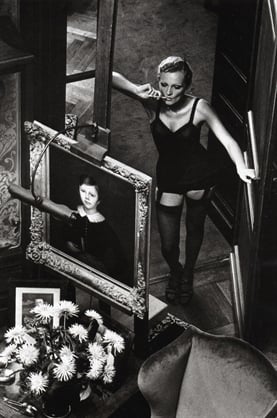Art World
Looted Masterpiece Discovered in Helmut Newton Photos


Henri Neuendorf

New evidence in the hunt for a lost Arnold Böcklin masterpiece has emerged from an unlikely source, the Art Newspaper reported. Looted from the collection of the Kulturhistorisches Museum in Magdeburg around the end of World War II, Tritonenfamilie (1880-81) was spotted back in 2004 in two Helmut Newton photographs by Andrea Linnebach, a Böcklin specialist at the University of Kassel.
The painting can be seen in the background of Newton’s Jenny Kapitan, Pension Dorian, Berlin (1977), which was shot at a Berlin hotel, and in a photograph of the Playboy model Yvonne Honsa (1999), taken in Newton’s Monte Carlo apartment.
The Kulturhistorisches Museum first learned of Linnebach’s discovery in 2008. Directors have since made several unpublicized efforts to obtain further information on the missing Böcklin piece from June Newton, the photographer’s 91-year-old widow.
It is unclear whether the masterpiece used as a prop was indeed the original painting. Matthias Harder, curator of the Helmut Newton Foundation in Berlin told the Art Newspaper “We know that it cannot be the original Böcklin.”
Yet there are no known replicas made by the artist, and the chances of a different painter copying the original after its disappearance are slim, as no color photographs of the original exist.
In 1943 the artwork was moved to a salt mine in Strassfurt for safekeeping. Museum historian Tobias von Elsner believes the original painting was probably looted by allied troops, German civilians, or forced laborers. It may also have been destroyed in a fire that broke out in the mine in 1945, although von Elsner believes the piece “probably survived.”
If the painting owned by Newton is the original, other missing paintings from the museum may have also survived. A significant number of masterpieces that were considered lost after World War II were recovered last year in the apartment of Munich collector Cornelius Gurlitt (see “Kunstmuseum Bern Accepts 1,300 Artwork Nazi-Era Gurlitt Collection Amidst Legal Battles”).